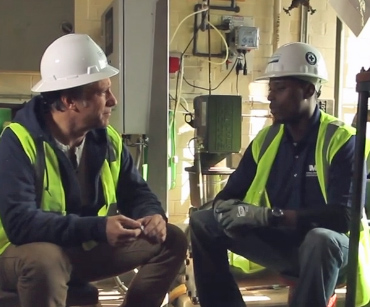
Couple months ago, I went back home to speak at a fundraiser for a organization called Project Jumpstart. The Project evolved when a group of Baltimore builders – desperate to hire skilled tradespeople but unable to find any – helped subsidize a pre-apprenticeship program that identifies and qualifies potential new hires.
The program caught my attention for two reasons. First of all, its success rate is extraordinary – 80% of Jumpstart graduates placed in the construction trades over the last ten years are still employed today. That’s unprecedented. Secondly, the majority of Jumpstart graduates are recovering drug addicts and non-violent offenders. In other words, the most successful pre-apprenticeship program I’ve ever seen, consists primarily of participants that most companies would never even interview.
This kind of success begs all sorts of questions, the most obvious being, what is Project Jumpstart doing right? The most obvious answer can be found in their staff. The instructors at Jumpstart are local, talented, and totally committed to the success of the program. But of course, that’s not the same as being committed to the success of each and every participant. The people who run Jumpstart understand the success of their program depends on the satisfaction of the companies who hire their graduates. Consequently, Jumpstart holds it’s participants to a much higher standard than similar programs.
For instance, Jumpstart participants are given a daily stipend to help make ends meet during the training process. But if you screw up, the stipend is withheld. Late for class? Shirt untucked? Cell phone goes off? You pay a price for your mistakes. And if your mistakes continue, you’re out of the project. It’s really that simple.
Not to belabor the point, but this level of accountability is very unusual in endeavors like Jumpstart. Most comparable programs are funded by government monies or well-intended individuals who are so determined to see every participant succeed, they refuse to leave anyone behind. Thus, lots of people graduate, but very few succeed. That doesn’t happen with Jumpstart. Here, participants are not only trained in the core competencies of the construction trades – they’re prepared for the realities of life on the job. There’s a focus on soft skills and work ethic, and no patience or pity for a lack of either. Consequently, the employers get candidates who are not only trained, but motivated, enthused, and eager to turn their lives around.
If you have a moment, check out the attached video. It’s very short, and uncharacteristically earnest for your’s truly. But I made it because other cities could easily follow Baltimore’s example – if they know about the program. Happily, the word is getting out. Check out this note I just received from Cincinnati.
“Two years ago, the Cincinnati-Hamilton County Community Action Agency and Ohio Valley Construction Foundation conducted a pilot project to determine if a career readiness program with a focus on the commercial/industrial construction would work to reduce poverty and increase community safety through employment of individuals with barriers from socio-economically challenged environments. While conducting the pilot in Cincinnati, these organizations also studied and learned from the JumpStart program in Baltimore which has demonstrated a 10 year record of success. The ongoing program in Baltimore and the results of the pilot in Cincinnati warrant further investment in this effort. Beyond presenting just the facts/numbers, the Baltimore Project JumpStart video with Mike Rowe was shown to all members of Cincinnati City Council to “seal the deal” for another round of funding. The program will be very beneficial to Cincinnati and its citizens.
Here are some statistics of the Cincinnati pilot program:
· 15 participants were enrolled
· 14 completed
· 79% employment rate
· 73% retention rate
It is our hope to fully fund a Project JumpStart type program in Cincinnati in late 2016.
John Morris
President
Share this thing, if you’re so inclined. I think it could be an important part of closing America’s skills gap.
Mike
PS Last time I posted about Project Jumpstart, some of you expressed “alarm” that I was rubbing shoulders with what felt like a “liberal endeavor.” Others were “appalled” that Charles Koch supported the same program. And many were “concerned” that programs like Jumpstart give undue favor to former convicts, when “honest people” are also in need of training.
Honestly, I have absolutely no idea what the politics are of those most responsible for Project Jumpstart. Nor do I care. Far as I’m concerned, the skills gap is a non-partisan problem, and work ethic is color blind. As for Charles Koch – I get it. He’s a wealthy and powerful man with strong views that many people disagree with. Personally, I like him, and find myself completely aligned with him on this issue. We don’t see eye to eye on everything, but I respect his opinions, and I’m grateful for his generosity with Jumpstart, as well as my own foundation.
As for my thoughts on crime and punishment, I think we’re seriously blowing it. Personally, I have no tolerance for violent felons, predators, thieves, repeat offenders, scam artists, or anyone who preys on the weak. On that score, I’m not nearly as forgiving as others, and my sympathies always lie with the victims. However – I’m confused and frustrated by the way we treat people who have paid their debt – especially non-violent offenders. On the one hand, we expect them to assimilate and reinvent themselves as productive members of society. On the other, we brand them forever as convicts, and demand to know the details of their incarceration at every turn. Tell me – how does one “re-assimilate” under such circumstances?
Seems to me, the whole concept of “paying your debt to society” relies upon society accepting your payment. But we don’t do that. We return convicts to the mainstream, with conditions that make their assimilation nearly impossible. We accept the payment, but we don’t forgive the loan. And that’s a recipe for, well…exactly what we have.
